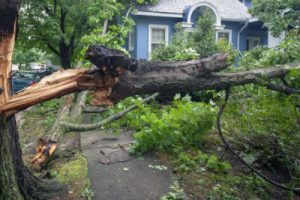
Autumn begins Sept. 1 and ends Nov. 30. And AccuWeather’s team of weather meteorologists have a special report for the United States’ 2022 fall forecast.
A combination of data from computer models, weather patterns around the globe and looking back at the last few years enabled AccuWeather’s long-range meteorologists to create a long-term forecast for autumn 2022.
In one word: warm.
“With pretty good confidence this year,” veteran forecaster Paul Pastelok said in the report, “I think it’s a mild fall setting up overall for the U.S.” Warm temperatures are forecasted from Connecticut to California, with rainfall surprises and tropical threats.
Extremes in precipitation this summer: from droughts and wildfires in the western and central U.S. to deluges and flash flooding on the East Coast, in the south and in St. Louis, no part of the country has missed hardship in 2022. But, what does all this mean for autumn weather?
Accuweather’s team forecasts warmer than normal temperatures remaining through October, which will delay the peak of fall foliage. The wait may be worth it, according to the report, when vibrant colors appear in the Northeast, Great Lakes and the Mid-Mississippi Valley. An increase in moisture is predicted to promote rain across the Northeast and Midwest, and wash away drought concerns in the autumn. However, the rain does not bring entirely good news.
“The severe weather threat will pick up again,” Pastelok said in the report. “We do feel a late-season surge may not be as strong as last year when we had quite a bit of tornadic activity, but I still think there’s going to be some and the peak month is October.” Cooler air will settle across the region after the severe storms in October.
This year is the 10-year anniversary of Superstorm Sandy, and multiple tropical storms made impacts last year in the Northeast.
“It is something to watch. But we just don’t have the confidence yet to say that a major strike is going to hit the Northeast at this point,” Pastelok said.
Americans in the Great Lakes and Northeast regions will be greeted with chilly air as autumn’s palette appears in October. AccuWeather’s team predicts the first frost will come one or two weeks earlier than usual, in late September and early October, in the Upper Midwest and upstate New York. Pastelok said, however, this first frost will not threaten agriculture in those regions.
The first snowflakes could fall in the Northeast and in higher elevations of the Appalachians in late October and into November thanks to a stormy pattern.
La Niña and The Bermuda High
She is back for a third year. Unusually warm waters in the Gulf of Mexico and a climate pattern unfolding thousands of miles away will influence weather in the Southeast, and the dominant factor for global weather will be La Niña. Cooler waters in the equatorial Pacific Ocean altering the jet stream and overall weather pattern in North America lead to La Niña.
“We do expect La Niña actually to strengthen a little bit during the latter part of the peak of the tropical season, meaning mid-fall, and it could have some impacts as far as tropical season,” Pastelok said. La Niña usually brings landfall of tropical systems to the Atlantic basin of the U.S.
However, AccuWeather’s team has had their eyes on the Bermuda High, a large area of high pressure stationed over the central Atlantic. The Bermuda High is “critical,” according to Pastelok, this tropical season, and has been stronger than normal this summer leaving the Atlantic basin dry and forcing tropical disturbances south. The Bermuda High is expected to weaken in the autumn and open the door for tropical storms to finally make their way to the U.S.
Sixteen to 20 tropical storms are expected in this hurricane season, including six to eight hurricanes, and four to six which will impact the coast U.S. According to the report, 21 storms were named last year, including seven hurricanes, and eight which affected the U.S. Three storms have been named in 2022: Tropical Storm Alex, Tropical Storm Bonnie and Tropical Storm Colin.
States from Florida to the Carolinas are predicted to experience most of the tropical storm activity, but the Atlantic Coast and the Gulf of Mexico should stay aware. As has happened in the last few years, “one big system” could make landfall in Texas or Louisiana, Pastelok said in the report.
Warmer water temperatures in the Gulf of Mexico could encourage tropical systems to gain strength in the Gulf. Moisture lifting from the Gulf over the Southeast, the mid-Atlantic and the Ohio Valley will clash with cold fronts and create severe thunderstorm conditions near Nashville and Memphis, Birmingham, Ala., Raleigh and Charlotte, N.C., Atlanta, Indianapolis, Cincinnati, and Louisville, Kentucky.
A wet autumn will almost guarantee the end of drought conditions in the Southeast, and while the same will ease up in the Northeast and Midwest, “abnormally dry conditions will remain locked in place across most of the central U.S. throughout autumn.”
“It’s going to take a lot to break this drought,” Pastelok said. “The area is going to be hurting. I think going at least into the first half of fall, the moisture is just not going to be there.” Accompanying the extended drought will be heat for the central U.S. The combination of extended drought and heat “will have severe implications on the nation’s agriculture,” the report states. Pastelok said a low supply of meat is predicted for fall and winter, because of the effects of drought and heat on cattle.
Of course, drought is predicted to create another wildfire season in the western states, which are already experiencing bone dry conditions and creating the perfect setting for wildfires. Fire season began in July with wildfires in Yosemite National Park and the McKinney Fire in northern California. In May, AccuWeather predicted wildfires would burn more acres in 2022 than in 2021, and 5.7 million acres have burned as of Aug. 1, 2022, nearly double this time last year.
The focus of wildfires in autumn is predicted in southern California in late September and into October thanks to the Santa Ana winds fanning flames. Central and Northern California are at risk as autumn begins.










